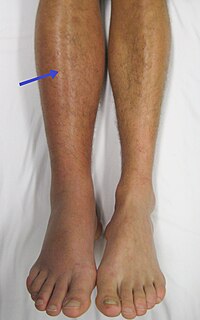
Photo from wikipedia
To investigate the clinical features of septic pulmonary embolism (SPE) cases and prognostic factors for in-hospital mortality in China. A retrospective analysis was conducted of SPE patients hospitalized between January… Click to show full abstract
To investigate the clinical features of septic pulmonary embolism (SPE) cases and prognostic factors for in-hospital mortality in China. A retrospective analysis was conducted of SPE patients hospitalized between January 2007 and June 2018 in the Department of Respiratory and Critical Care Medicine, The First Affiliated Hospital of Guangxi Medical University. A total of 98 patients with SPE were identified. All patients had bilateral multiple peripheral nodules on chest computed tomography. The most common pathogen found in blood culture was Staphylococcus aureus (10/33, 30.3%). Transthoracic echocardiography was performed in 39 patients and 20 showed vegetations. Bronchoscopy was performed in 24 patients. Bronchoalveolar lavage fluid (BALF) was obtained from 15 patients (62.5%) and showed predominantly polymorphonuclear cell infiltration (52%, range of 48%~ 63%). Four patients received transbronchial lung biopsy, and histopathological examinations revealed suppurative pneumonia and organizing pneumonia. The in-hospital mortality rate was 19.4%. Age (odds ratio [OR] 1.100; 95% confidence interval [CI] 1.035–1.169), hypotension (OR 7.260; 95% CI 1.126–46.804) and ineffective or delay of empirical antimicrobial therapy (OR 7.341; 95% CI 1.145–47.045) were found to be independent risk factors for in-hospital mortality, whereas drainage treatment was found to be a protective factor (OR 0.33; 95% CI 0.002–0.677). SPE cases presented with nonspecific clinical manifestations and radiologic features. Blood cultures and bronchoscopy are important measures for early diagnosis and differential diagnosis. There is relationship between primary infection sites and the type of pathogen. Maintaining normal blood pressure and providing timely and appropriate initial antimicrobial therapy for effective control of the infection could improve prognosis.
Journal Title: BMC Infectious Diseases
Year Published: 2019
Link to full text (if available)
Share on Social Media: Sign Up to like & get
recommendations!